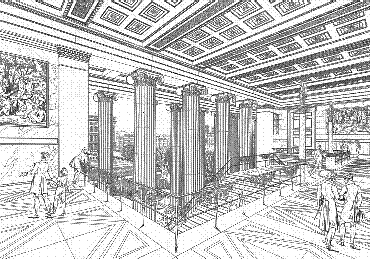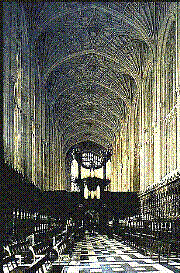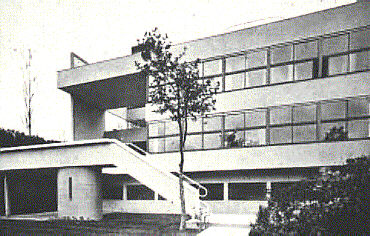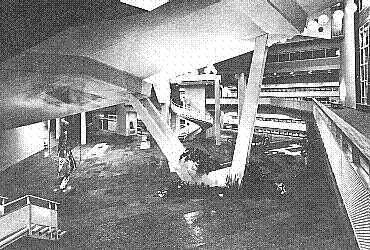| |
A critical analysis of Colin St. John Wilson's "The Natural Imagination: an essay on the experience of architecture".
Wilson's essay first appeared in The Architectural Review, January, 1989, v. 185, no. 1103, p. 64-70.
| |
Introduction
Wilson's text builds upon the tradition whereby the human body serves as an enabling metaphor that enlightens the experience, understanding, and ultimately the design process of architecture. This position is similar to the notions of the body, the imagination, and architecture presently under investigation within the theory of chronosomatics, however, the two positions arrive at different conclusions. The objective of this analysis, therefore, is to first cite where the two theses share common ground, and then, more importantly, pinpoint where the two positions diverge.
Note on the Analytic Procedure
Specific passages from Wilson's text are highlighted in red, and it is these citations that relate directly to the analysis. Wilson's text and the text of the analysis are placed side by side with the intention of enabling a synergic reading of both.
|
The Natural Imagination An Essay on the Experience of Architecture
Colin St. John Wilson
'It is not the rationalization that was wrong in the first (and now past) period of modern Architecture; the wrongness lies in the fact that the rationalization has not gone deep enough . . . The newest phase of architecture tries to project rational methods from the technical field out to human and psychological fields.'
Alvar Aalto: 1940
'But suddenly you touch my heart . . .'
| |
Further Deepening the 'Natural Imagination'
Stephen Lauf
To paraphrase Aalto, finding a deeper meaning in architecture requires a search that moves beyond the technical and towards the visceral.
viscera The internal organs, especially those of the great cavities of the body, as the stomach, heart, lungs, etc., commonly, the intestines.
|
In the prologue to his celebrated panegyric on the Acropolis, Le Corbusier draws attention to a commonly felt distinction. 'You employ stone, wood and concrete and with these materials you build houses and palaces; that is Construction. Ingenuity is at work. But suddenly you touch my heart. You do me good, I am happy and I say: "This is beautiful. That is Architecture".'1 He then makes a series of references to 'a resonance, a sort of sounding-board which vibrates in . . . an axis of organisation'; and with Ozenfant (in the first number of L'Esprit Nouveau) he explores the
'physical-subjective facts which exist because the human organism is as it is'.
But, to use Aalto's phrase, he did not go 'deep enough'.
| |
The objective of this analysis is to demonstrate the very real possibility of exploring more deeply the 'physical-subjective facts which exist because the human organism is as it is' by looking beyond the superficial aspects of the human figure and towards the human body's internal operations.
|
Some kind of revelation has occurred, in pure immediacy, unsought and unexplained: and that is a mystery.
Most critics step down from the challenge because they do not have an explanation that is neat. But the mystery doesn't go away; we can still be moved deeply by buildings yet have no adequate terms to deal with the fact. We are normally very disinclined to talk about this in the same way that we find a verbal account of sexual attraction to be hopelessly inadequate. (There are some common features in the psychic chemistry of the two phenomena, a split-second immediacy of sensation, a mingling of the visual and the visceral, an uncanny awareness of some magnetic charge in the air, of a jolting presence, of time suspended.) For my own part I need to know why I can be so deeply moved in the presence of certain buildings--
on the turning of the stair in the portico of the Altes Museum, on the terraces of Garches, in the foyer of the Philharmonie, in the nave of King's Chapel, the impluvium of the House of the Tragic Poet, in the Gallery of the Bradbury Building
. . . It would seem that to multiply examples would be merely of personal interest--until one significant feature of the list is noticed; these occasions have nothing in common at the level of style, function or structure.
In traditional terms therefore we cannot look for an answer to the Vitruvian categories of Firmitas or Utilitas nor (if we take it to refer to stylistic rules) Venustas.
Clearly therefore the secret of this elation lies in the experience of some more primal conjunction of forms, as if to say that our experience of architecture is somehow divided in itself into frames of super- and infrastructure.
It is as if we are being manipulated by some subliminal code, not to be translated into words, which acts directly on the nervous system and the imagination at the same time, stirring intimations of meaning with vivid spatial experience as though they were one thing--something like Wordsworth's great evocation of 'unknown modes of being' provoked by our wonder at Nature, only this time provoked by structures and images that are man-made. What is the chemistry of this transforming power, from what sources does its compelling force derive, and what is the code through which it works?
| |
The similarities between Wilson's notion of the 'natural imagination' and the chronosomatic imagination as it relates to architecture begin in earnest with the list of built places that 'deeply move' Wilson. In this initiation of his overall thesis, Wilson presents places that somehow manifest a mysterious emotion-producing power, and it is this mystery that is unraveled through his ensuing essay. Starting with the first clue that the bond of these 'occasions' has nothing to do with a similarity in 'style, function or structure', it thus becomes readily possible to dismiss the traditional Vitruvian aesthetic categories of Firmitas, Utilitas and Venustas. Therefore, following the lead of Le Corbusier and Aalto, Wilson finds it logical to search inward for 'some subliminal code' or 'chemistry' that effects human perception and imagination, and, moreover, he seeks the origin of this operation as well.
Because of my own reseach in applying chronosomatic theories of the imagination to the process of architectural design, I was able to immediately guess what the places in Wilson's list have in common, and, as I continued to read the essay, I was proven correct in my hypothesis. Without prematurely disclosing the outcome of Wilson's essay, I will nonetheless name the 'code' and 'chemistry' behind the 'deeply moving' architectural experiences.
Each of the 'occasions' in Wilson's list is osmotic.
osmosis : 1 the flow of diffusion that takes place through a semi-permeable membrane (as of a living cell) typically separating either a solvent (as water) and a solution or a dilute solution and a concentrated solution and thus bringing about conditions for equalizing concentration of the compounds on the two sides of the membrane because of the unequal rates of passage in the two directions until equilibrium is reached, esp.: the passage of solvent in distinction from the passage. 2a : an interaction or interchange (as of cultural groups or traits) by mutual penetration esp. through a separating medium. 2b : a usually effortless often unconscious absorption or assimilation (as of ideas or influence) by a seemingly general permeation
|
Colin St. John Wilson is deeply moved in the presence of these buildings and he needs to know why.
| |
Altes Museum
Karl F. Schinkel
| |

|
left
King's College Chapel
Cambridge, England
right
Bradbury Building
George C. Wyman |

| |

|
Villa Garches
Le Corbusier
| |

|
Philharmonie
Hans Scharoun
| |

|
|
| |
|




